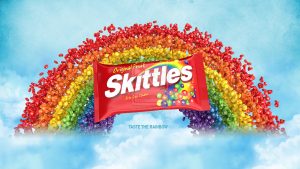Learning Objective: I can collect the probability of Skittle colors and determine a relative frequency.
This is a real world application problem connecting probability in a context students enjoy and understand, candy! This activity allows students to evaluate a regular sized packet of Skittles by determining the frequency of each flavor. Everyone has a favorite Skittle, whether it is the cheery red or the new green apple green. This way students can evaluate how frequent their favorite colored Skittle is in typical packet of Skittles. As students participate in this activity they are connecting aspects of mathematics into a context problem that appeal to their lives. When students relate mathematics to real life situations they are able to connect its importance. Then, students can participate in a mathematical discussion to reason abstractly about the probability of different colored Skittles to determine the relative frequency found in all bags. As they discuss the problem students will be making sense of problems. When the students discuss the frequency and probability of skittles in the bag, they can relate it to the production of Skittles, which opens a discussion where students participate as responsible citizens by gaining further knowledge.
As students investigate the frequency of skittle flavors in their designated bags, they can create different representations to demonstrate the date. These representations can be frequency tables, frequency graphs, pictograph, histograms, line graph, bar graph, etc. As they apply these different representations the Skittle problem they are practicing areas of mathematics. Also, students can then relate the information to their classmates and discover patters to determine the relative frequency of Skittle flavors.
CCSS.Math.Content.7.SP.C.6
Approximate the probability of a chance event by collecting data on the chance process that produces it and observing its long-run relative frequency, and predict the approximate relative frequency given the probability. For example, when rolling a number cube 600 times, predict that a 3 or 6 would be rolled roughly 200 times, but probably not exactly 200 times.
CCSS.Math.Practice.MP1 Make sense of problems and persevere in solving them.
CCSS.Math.Practice.MP2 Reason abstractly and quantitatively.

I enjoyed reading this, I really love this idea, it seems like a fun activity that will help students understand how probability works. I would also suggest using the same steps for this problem with different candies like M&M’s, Smarties, Gummy Bears, Starbursts, Jelly Beans, and the list could go on. I look forward to doing this activity in my future classroom. Another idea could be to use different candies across the world, this could help to integrate cultures within your classroom. Thank you for sharing!